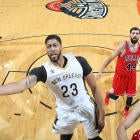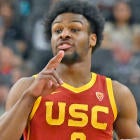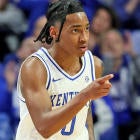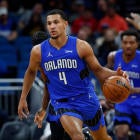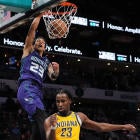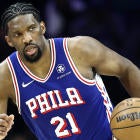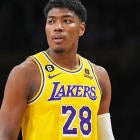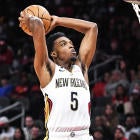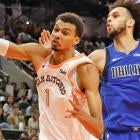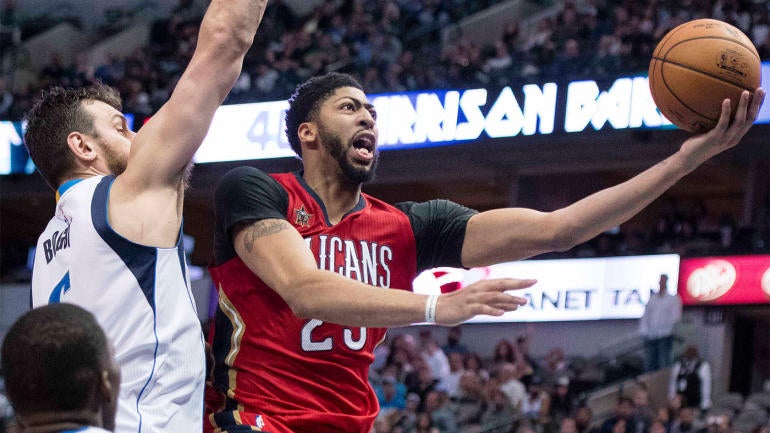
The power forward position has gained increased attention in recent years, highlighted by the true emergence of the stretch four, a rangier big who steps out beyond the arc and knocks down threes.
We've nearly reached the point where it's become an oddity if a team's power forward can't shoot threes at a respectable clip. To some extent, when trying to choose between those players in fantasy, you're splitting hairs. Their age and level of responsibility often become the deciding factors.
For a player to truly stand out at the position, they must bring something more to the table, like rebounding, defensive production, or playmaking.
Beginning with the household names in Tier 1, we'll take a look at how to evaluate the NBA's fantasy-relevant power forwards for the 2017-18 season.
Tier I: The Stars
Anthony Davis, Blake Griffin, Draymond Green, Kevin Love, Kristaps Porzingis, Paul Millsap
Few doubts remain regarding Davis' status as one of the best big men in the NBA, though concerns about his durability are valid. The 2016-17 campaign was his healthiest to date, but he still appeared in just 75 contests, and through his first four NBA seasons, Davis averaged 65 games played per year. Still, he posted 28.0 points, 11.8 rebounds, 2.2 blocks, 2.1 assists and 1.3 steals per game a year go, a stat line nearly impossible to pass up if he falls out of the top five picks.
Like Davis, it's important to at least take note of Griffin's injury history, as he's averaged just 54.3 games played over the past three seasons. Where Griffin separates himself from other power forwards is his ability to run an offense, a skill that should be on display more often in the wake of Chris Paul's departure. Assists are extremely difficult to come by from the power forward slot, so drafting Griffin early makes the need for an elite point guard less pronounced, especially in categorical formats.
In moving to Denver, Millsap enters a more efficient, faster-paced offense and avoids playing with a lane-clogging center in Dwight Howard. Two seasons ago, more than 36 percent of Millsap's field goal attempts came from within three feet of the rim. That number sunk to 25.4 percent last season.
Other players who may be position-eligible: Giannis Antetokounmpo, Paul George, DeMarcus Cousins, Myles Turner, Carmelo Anthony
Tier II: The Established Mid-Tier
LaMarcus Aldridge, Serge Ibaka, Tobias Harris, Zach Randolph, Derrick Favors, Markieff Morris, Dirk Nowitzki
After being dealt to Toronto at the deadline, Ibaka averaged 14.2 points, 6.8 rebounds and 1.4 blocks across 31.0 minutes while shooting 45.9 percent from the field and hitting 1.8 3's per game. It's possible he'll see more minutes at center next season given his ability to space the floor, but given Toronto's high-usage backcourt, more time at center likely wouldn't move the needle much in terms of his Fantasy value.
Randolph may present the most risk out of anyone in this category due to his age (36) and dramatic change of scenery, but his workload shouldn't see too much of a drop-off considering he's far and away the most experienced frontcourt option. Last season, Randolph transitioned to a bench role and averaged 14.1 points, 8.2 rebounds and 1.7 assists while shooting 44.9 percent from the field.
When healthy, Favors has flashed a borderline-All-Star-caliber ceiling. From 2013-16, Favors averaged 15.2 points, 8.4 rebounds, 1.5 blocks, 1.4 assists and 1.0 steal, while shooting 52.1 percent from the field. With the departure of Gordon Hayward, Favors should see an increased role within the Jazz offense. But betting on him to play more than 70 games is a risky proposition.
Other players who may be position-eligible: Nerlens Noel
Tier III: The Up-and-Comers
Dario Saric, Aaron Gordon, Julius Randle, Marcus Morris, JaMychal Green, James Johnson, Marvin Williams
Though the 76ers went ahead and signed veteran power forward/center Amir Johnson over the summer, as well as added a healthy Ben Simmons to the fold, Saric will still be a fixture in the rotation. After the All-Star break last season, Saric recorded 17.3 points, 7.3 rebounds and 3.4 assists in 30.4 minutes per game. His efficiency leaves something to be desired, but he partly makes up for it with his work on the glass and decent assist total for a wing
Gordon is another player whose role changed significantly post-All-Star break after the trade of Serge Ibaka allowed Gordon to slide up from small forward to power forward, helping his rebounding and securing more touches on offense. After the break, Gordon averaged 16.4 points, 6.2 boards and 1.7 assists in 31.2 minutes per game and shot better than 50 percent from the field. While his outside shooting is still a work in progress, if he improves even slightly as an outside threat, he could be among the league's most improved young players.
Despite starting 75 of 77 games, Green put up just 8.9 points across 27.3 minutes per game, to go with 7.1 rebounds. While he was a low-volume scorer last season, he was efficient, shooting 50.0 percent from the field and going 55 for 145 (37.9 percent) from beyond the arc.
Tier IV: The Interchangeables
Thaddeus Young, Al-Farouq Aminu, Jon Leuer, Ryan Anderson, Trevor Booker, Taj Gibson, Ersan Ilyasova, Gorgui Dieng
Aminu took a step back in the scoring department last season, seeing his effective field-goal percentage drop from 50.3 to 46.8 and his points sink from 10.2 to 8.7 per game. However, he improved on the glass, raising his rebounds from 6.1 to 7.4 per game. He's largely a catch-and-shoot player and doesn't do much for passing (1.6 assists), but he holds his own defensively, posting a combined 1.7 steals and blocks per game.
Leuer had the biggest workload of his career last season, averaging 25.9 minutes per game and starting 34 of the 75 games in which he appeared. He averaged a career-high 10.2 points per game, while chipping in 5.4 rebounds and 1.5 assists per game. His 3-point percentage (29.3) was uncharacteristically low, so it's quite possible last season was an outlier in that department.
With the Hawks entering a full rebuild, Ilyasova could be in line for an uptick in offensive responsibility, even if that just means he's a high-volume stretch four. Atlanta did spend a first-round pick on promising forward John Collins, who turned heads in Summer League, but he's still a rather undeveloped talent.







